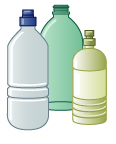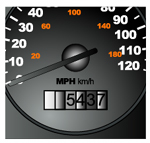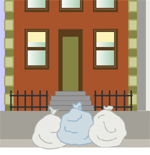
Click here to play The Garbage Game
What did you throw in a trashcan today? You probably did not give it much thought. But every week you and your fellow New Yorkers throw away 64,000 tons of garbage. That comes out to almost 7 billion pounds of garbage every year -- and that does not even include what gets thrown away in offices, factories and construction sites.
Whisking off the detritus of our daily lives costs the city government more than a billion dollars a year. More than 5,000 trucks carry our banana peels, batteries, battered tennis balls and discarded deli containers from one part of the city to another, belching diesel fumes all the way. Trucks, trains and barges haul our waste to landfills and recycling centers in other states -- and even other continents.
Over the years, New York City has put forth a number of schemes to deal with its garbage. All of them involve tradeoffs. None of them is remotely perfect. Later this week you will be able to play Gotham Gazette's Garbage Game and design a waste management plan for New York City. As that game will make clear, nothing is simple about managing the refuse of 8 million people.
MILLIONS OF INDIVIDUAL DECISIONS
Every day we all find something in our hands that we think we can no longer use. What happens to it then? That decision, made dozens of times a day by millions of people, affects how much garbage and what type of garbage the Department of Sanitation must process.
Here are some typical items.
Plastic Water Bottles
Methodology: There aren't good figures available for water bottle reuse, so we decided, a bit arbitrarily to figure that a plastic water bottle will get refilled about three times on average before it is lost or discarded. Based on that, reusing water bottles reduced the volume of water bottle waste in the garbage stream to 25 percent of the 17,677 tons that New Yorkers currently generate each year or some 4,419 tons of the bottles a year. |
With every Dasani, Poland Spring or Evian bottle you consume, comes another -- some think wholly unnecessary -- addition to the city's waste stream.
People in New York City buy about 9.82 billion water bottles a year, according to an estimate gleaned from data compiled by the Container Recycling Institute. The Department of Sanitation estimates 17,677 tons of water bottles are discarded into the residential waste stream per year.
Nationally those figures can be even more astounding. In 2006, Americans bought 50 billion water bottles -- 167 for every person in the country. An estimated 25 percent of them were recycled.
While some of this water originates from the Alpine springs in Livingston Manor, New York, or other pure water sources throughout the world, approximately 25 percent of all bottled water comes out of a tap.
So some question why New Yorkers need to buy it at all. New York's tap water is so pure -- it originates in streams upstate -- that most of it does not need to be filtered. This summer the city launched a "Get Your Fill" campaign to convince New Yorkers to give up their Poland Spring entirely.
For those who refuse to go that far, refilling that bottle one, two or even three times can make a difference. "For every one bottle that is reused, compared to one that is discarded, that is meaningful," said Allen Hershkowitz, director of the solid waste program at the Natural Resources Defense Council.
Giving up or cutting down on bottled water also saves money. According to the New York Times, it costs 49 cents a year to use New York City tap water, while it costs $1,400 a year to purchase bottled water.
Plastic water bottles comprise only a small portion of the plastic, metal and glass that make up the city's recycling stream. Every New York City household recycles about 2.9 pounds of plastics, metals and glass per week, and all plastics, including water bottles, make up 13 percent of the glass, metal and plastics collected for recycling in the city. About half of those are plastics made from recyclable polyethylene terephthalate, which is what water and soda bottles are made from.
Cloth and Other "Reusables'
Methodology: According to "Reaching for Zero," a 2004 report on reducing garbage in New York City, New Yorkers throw away 18,556 tons of towels, sheets & pillowcases a year. Reusing it as a rag or donating it to charity so others can use it extends the use of the cloth, keeping it out of the waste stream longer. Based on that, we reduced the amount of garbage in the waste stream from household linens by 50 percent for those reusing it or donating the towel. We did not consider the considerable amount of paper waste that would not be generated if more people used and reused old cloths for household chores. |
New Yorkers throw away 18,556 tons of towels, sheets and pillowcases and a total of about 190,000 tons of recyclable textiles a year.
Currently, New York City does not offer any alternatives to throwing these items in the household trash. But there are other possibilities.
One person's garbage is another one's gold. You may be sick of that chartreuse terry cloth but it could be just the thing for another New Yorker. Many organizations in the city, including Goodwill, the Salvation Army and various houses of worship, collect used material and donate it to needy people or sell it for a very low price. Eventually, getting rid of it will be that person's responsibility.
And even if you hold onto that towel, you may still be able to put it to good use. Beyond keeping your towels out of the waste stream for a while, using and reusing worn-out cloth for household chores reduces the use of paper towels and other disposable products. More than 90 percent of U.S. homes use paper towels, producing 3,000 tons of waste a day and destroying vast tracts of forest. Every year, one producer -- Kimberly Clark -- uses about 39 million cubic feet of trees from Canada's boreal forests to produce paper towels, napkins and tissues.
New York City currently makes no effort to recycle or compost discarded textiles, although a garbage plan approved by the City Council in 1992 called for recycling of 25 materials, including cloth. This year, the Council on the Environment of New York City conducted a pilot program with Goodwill Industries at the Union Square green market to collect used textiles suitable for recycling. In three months, it collected more than 12,000 pounds.
Food Waste
Methodology: If you compost your food waste yourself, it will stay out of the city's waste stream, turning up instead as soil for your own backyard or the local community garden. Otherwise you leave the waste for the city to take care of either for compost (not yet an option) or in the landfill. Of course you could divide your food garbage, composting some at home and putting the rest out at the curb. But for simplicity we decided it was all or nothing: 745,000 tons diverted or 745,000 tons to the city. |
Food waste accounts for about 22 percent of all residential garbage thrown away in New York City, with lawn clippings, dried leaves and the like making up another 6 to 7 percent, according to New York City 2004 Waste Characterization Study.
In New York City, almost all of that goes to a landfill. Some individuals and some other cities, though, give an apple core or carrot peel a second life through composting. Composting is the controlled decomposition of organic material so that it becomes soil.
If New Yorkers went all out and composted food scraps and other compostables with our yard waste, up to 30 percent of the city's refuse by some counts could avoid the landfill.
New York has made some modest efforts in this direction. The Department of Sanitation collects and composts leaves, some yard waste and Christmas trees and runs a composting operation on Riker's Island that processes food waste from the jails there. Some community gardens compost food waste.
In the late 1990s, the city conducted a pilot program for backyard composting and concluded that a citywide program would divert 109 tons a week or just 0.15 percent of the waste stream. But some cities have done far more. In 2005, running out of landfill space, Toronto instituted its Green Bin program. Residents sort out compostable materials -- apple cores, coffee grounds, used tissues --and put them in a special bin. The city collects the waste and processes it, producing soil for farms and parks. Officials hope the program will reduce the amount of Toronto's garbage headed to landfills by about 30 percent.
Diapers and Other Difficult Garbage
Methodology: The Waste Characterization Study found slightly more than 4 percent of residential garbage in the city consists of disposable diapers and sanitary products. We estimated diapers make up the bulk of that, which would be about 116,480 tons of diapers a year. All that goes in the landfill, unless the family uses cloth. |
Some things are not easy to lift out of the waste stream, such as heavily soiled manufactured products or items with toxic materials. Diapers present a classic example.
If you have a baby, you are going to use diapers -- at least for a year or two (or four). Most families -- around 90 percent -- opt for disposables over cloth ones. With the average baby going through about five a day -- or more than 1,800 diapers a year -- it is easy for the city to accumulate a vast amount of waste. Americans throw away 3.6 million tons of diapers a year. With New York City having a baby boom of sorts, the Department of Sanitation picks up a lot of diapers at the curbside.
Some disposable diapers can be composted, but New York City doesn't have any plans in the works to take diapers in a regular compost pickup. In the landfill, standard disposable diapers can take 500 years to break down. Using cloth diapers would certainly reduce garbage in the landfill. But otherwise, the decision is not so clear cut: Disposable diapers use 29 percent less energy than cloth diapers washed at home and less water as well, according to the Institute for Lifecycle Environmental Assessment.
Other alternatives have emerged. Manufacturers have developed flushable diapers, which reduce the amount of garbage in the landfill, or diapers that break down more rapidly. Toronto accepts diapers for composting, but the city must separate out the plastic covering and send that to a landfill.
Methodology: Since about 1 million tons of paper enter the city's waste stream annually, those of you who decided to reuse your junk mail for your grocery list in our garbage game deserve a break. Albeit arbitrarily, we figured half the amount of junk mail might enter the stream if every New Yorker did this. So, instead of 1 million tons, you got 500,000. |
Paper
More than half of the waste paper generated in the city is thrown out as opposed to being recycled. That's out of about 1 million tons annually.
From faxes to junk mail, New Yorkers have had the option to recycle paper since the early 1990s. Out of all of the city's recyclables, paper recycling has arguably the most support, and New Yorkers are most likely to actually do it. Following the city's budget crunch during the recession earlier in the decade, a public outcry persuaded Mayor Michael Bloomberg to retain paper recycling when other recycling programs were suspended. Even so, New Yorkers historically have not been the most avid recyclers. Only 45 percent of paper in the city is recycled, totaling an estimated 366,000 to 423,000 tons a year and 4.2 pounds of paper per household weekly.
Half of the mixed paper collected by the Department of Sanitation is delivered for processing to a number of private companies. The other half goes to the Visy Paper Mill on Staten Island, where it is turned into linerboard for corrugated cardboard packaging products.
E-waste
Methodology: In our garbage game, we have given credit to those of you who decided to give your phone away to charity or back to your cell phone provider. Given the difficulty of finding information on how this can affect the entire city's waste stream, we halved the 158 tons of cell phones that went into the waste stream, and gave you 79 tons instead. |
Nearly 25,000 tons of electronic waste are thrown out in New York City annually out of the 92,000 tons New Yorkers purchase. E-waste makes up about 2 percent of the city's waste stream, according to the Department of Sanitation. Cell phones, the city says, comprise only about .005 percent of the total waste stream or 158 tons per year. Despite its relatively small quantity, e-waste contains some of the most potentially hazardous toxins, according to the Department of Sanitation. Improper disposal of e-waste is responsible for up to 70 percent of the toxic heavy metals in landfills.
While the city does not have its own electronic recycling legislation, the Department of Sanitation organizes drop off events, where residents can leave their defunct computers, cell phones, televisions and other electronic devices. Advocates claim these programs are extremely successful. More than 8,000 New Yorkers brought 311 tons of electronics and 2,300 pounds of cell phones to 14 recycling events in fiscal year 2006. The Lower East Side Ecology Center has collected over 92 tons of electronics from New Yorkers who came to 11 collection events organized in 2007, according to the office of City Councilmember Bill De Blasio. Even so, less than 10 percent of the city's e-waste is recycled, according to one estimate.
Charities, particularly groups working with victims of domestic violence, collect electronics for reuse or recycled parts. New Yorkers can also bring their old cell phones back to the original provider. A state statute requires cell phone stores to accept as many as 10 phones per person annually for recycling.
The City Council is considering e-waste legislation that would require manufacturers of many types of electronics, from computers to televisions, to recycle the electronics they produce. City officials predict the legislation will be approved this fall.
BEYOND THE CURBSIDE

Your home trash sorting is a tiny piece of the city's waste management puzzle. Once it all leaves your curbside, the real debate kicks in. How should we transport our garbage? Which neighborhoods should have the facilities that process and sort our garbage -- along with the diesel-spewing trucks that transport it? How much money should the city spend to sort out recyclables and make sure they're really recycled? How far should we truck our trash?
These are just some of the questions that city officials have pondered for decades or, rather, centuries.
Recycling
Methodology: To calculate the number of miles garbage would travel under your plan, we used Mapquest to figure the distance from City Hall to your destination - whether it was a local transfer site (the Gansevoort peninsula at 14th Street), a site in the outer boroughs (an acceptance center in Greenpoint, Brooklyn), a site in New Jersey (a center in Jersey City, N.J.) or the citywide center in Sunset Park. For calculating miles by barge, we used Google Maps' Pedometer and found the most direct route by water. To determine rail mileage, we also used Pedometer to follow railroad tracks from the city to a Sims Group site in Virginia. Next, we took your total tonnage for each mode of transport and multiplied it by the number of miles. We then took that sum and divided it by how many tons vehicle can hold:- 1056 tons for a barge, 90 tons for a rail car, 12 tons for a sanitation truck and 52.5 tons for a tractor-trailer. That enabled us to factor in how many trips a truck would need to carry as many tons as a barge. |
In some form, recycling initiatives in New York City date back to Peter Stuyvesant. In the mid-17th century, Stuyvesant convinced New Yorkers, or shall we say "New Amsterdamers," to responsibly dispose of their oysters and dead animals, instead of thrusting them into the street. More than a century later, the city - thanks to Col. George Waring - had its first curbside collection program, where residents separated their paper, metal, rags, animal products and wood for collection by the city. The program did not last long though, thanks to Tammany Hall and the ousting of a reform agenda, and the city was back to dumping its trash in the ocean.
New York enacted a major recycling law in 1989. That summer, the department launched what would become the first citywide curbside collection of recyclables in New York history. By mid-2002, New Yorkers were recycling about 20 percent of the city's total residential waste stream. But that year, facing a financial crunch, the Bloomberg administration "suspended" the recycling of metals, plastic and glass. Cutting back on recycling, the administration argued, would reduce the number of garbage collection trucks and so save the city $51 million a year. City Council balked, however, and eventually compromised with the mayor: Metal recycling would continue and recycling of plastic and glass would resume within two years. Paper recycling also continued throughout this period. As the cuts were implemented, many of the proposed savings never materialized.
In spring 2004, the recycling of glass and plastic resumed. But more than three years later, some experts believe the city still feels the effects from the suspension of some recycling.
While recyclable materials make up about 36 percent of the city's waste stream, only about 18 percent of the city's residential waste actually is recycled. This means that half of the recyclable materials in the city are thrown away, end up in a landfill or are burned in an incinerator.
The First Destination
Many of the city's recyclables are handled in neighborhoods in poor and minority communities in the outer boroughs. Local activists and environmentalists say the diesel spewing garbage trucks pollute these areas while Manhattan has not had to deal with its waste -- that is until now. The Bloomberg administration says that taking recyclables to local stations in each of the boroughs, including Manhattan, would consume less energy and reduce pollution. Its solid waste management plan requires that the city's recyclables and refuse be taken via barge or rail to stations located in all five boroughs.
The most controversial part of that plan calls for building a recycling center on the Gansevoort peninsula in Hudson River Park. Some Manhattan residents and politicians (though not all) have objected, saying the facility would intrude on needed parkland.
Manhattan Assemblywoman Deborah Glick says parkland is too valuable to take it away for any type of development. Glick, along with parks groups and other Assembly members, is blocking legislation in Albany that would make way for the station. They want it moved to Pier 76 near 36th Street.
Other environmental activists disagree. "It's Manhattan using its privilege," Elizabeth Yeampierre, chair of the New York City Environmental Justice Alliance and executive director of UPROSE, a Latino community group based in Sunset Park, Brooklyn, said this summer. "We want to let Glick know she is in the way. She is in the way of borough equity."
Without Gansevoort, most of Manhattan's recyclables stay on the sanitation truck that collects them at the curb until they reach New Jersey, where they are processed. This accounts for an estimated 700,000 truck trips a year. Recyclables collected in the other four boroughs arrive at one of several private facilities.
As part of its solid waste management plan, the city wants to phase out trucking from borough to borough but has not yet met that goal entirely either. It plans to eliminate about 55,000 vehicle miles by transporting recyclables by barge. Putting materials on a barge and sending them down the East River produces fewer emissions in the city than shipping the material on trucks, city officials say.
The Economics of Recycling
Methodology: To calculate the cost of recycling, we used a figure from the city's Independent Budget Office, which includes the entire operating cost at $206 per ton. We then multiplied that by the number of tons you decided to recycle. |
Beyond where the trash goes and how it gets there, officials estimate it could eventually be cheaper for the city to recycle than simply dump the trash in a landfill or incinerator. The city pays $206 per ton to take away recyclable metal, glass and plastic, while it pays $167 per ton to get rid of refuse (unrecycled trash), according to the Independent Budget Office. The Independent Budget Office has concluded the cost of recycling for the city could go lower than the cost per ton for refuse if New Yorkers recycled more of their garbage.
The city has established a 20-year contract with the Sims Group to build a large citywide recycling center in Sunset Park. The citywide facility costs an estimated $45 million and will create about 160 construction jobs and 100 permanent jobs. Sims, not the city, is covering the cost of construction.
The administration's plan for the central facility replaces many small private contractors with one company. This, the administration hopes, will save money by insulating the city from fluctuations in the market for recycled materials. Sims, which handles the majority of the city's recyclable waste, deals secondhand materials all over the world.
Exporting Garbage
Most of the city's recycled raw materials are exported. Because of a shortage of forestry resources, the appetite for U.S. recycled paper products has grown tremendously, especially in China. The largest export from the Port of New York and New Jersey is scrap paper, according to the Natural Resources Defense Council. But the secondhand market can be extremely competitive. Materials from commercial businesses are worth more than residential waste because they are more homogeneous.
The shipping has environmental costs as well. International ship emissions account for more than 14 percent of nitrogen emissions and more than 16 percent of sulfur emissions worldwide. Today's large cargo ships can release as much pollution in one hour as 350,000 cars. On the other hand, it can be a challenge for raw material processors to sell their products here, partly because of the high cost of doing business in New York City.
"We don't have a great deal of end use capacity manufacturing because of the high cost of living in the middle of New York," said David Hurd, director of the Office of Recycling Outreach and Education at the city's Council on the Environment. "As a material processor you sell to the highest bidder."
Still, approximately 50 percent of the paper collected in the city is processed here. At Visy Paper on Staten Island, paper is turned into corrugated cardboard, and the city collects taxes at almost every stage. Some claim by exporting the paper, the city loses revenue.
The Rest of the Garbage
Methodology: To compute carbon emissions we used figures from the Environmental Protection Agency's Emission Control Lab, which measured emissions, including hydrocarbons, carbon monoxide and nitrous oxide, in pounds for every gallon of diesel fuel burned per mode of transport. For rail freight that number is .5919 pounds, .7519 for trucks and .4206 for barges. We then used figures from the Bureau of Transportation Statistics cited in a study from Columbia University to calculate how many gallons a truck, barge or railcar used to travel a mile per 1,000 tons. We multiplied these two numbers to determine how many pounds of emissions were produced per mile of transport for every 1,000 tons. Doing this, we determined a truck produces 6.26 pounds of emissions to carry 1,000 tons of trash per mile, rail produces 2.49 pounds per mile for 1,000 tons of trash and a barge produces 1.32 pounds per mile for 1,000 tons of trash. We then divided the amount of tons you used during a particular mode of transport (for instance, carrying your recyclables from New York City to Hong Kong) by 1,000 and multiplied it by how many miles the garbage would go. These emissions are for transportation only. |
All of the garbage thrown out in New York City on one day could fill the entire Empire State Building. And several years ago, it all went to Fresh Kills, the massive Staten Island landfill, now being converted into a park.
When Fresh Kills opened in 1947 as a temporary landfill, the city intended to close it three years later. Instead it remained open until 2001, much to the dismay of many Staten Island residents. Fresh Kills became one of only two man-made structures (along with the Great Wall of China) that can be seen from space. In 1996, after Staten Island voters played a key role in making him mayor, Rudolph Giuliani said he would shut the huge landfill. Except for accepting debris from 9/11, it closed in 2001.
Whatever the merits of closing Fresh Kills, the city had no real plan to replace it. The Sanitation Department began sending its trucks to private transfer stations, where the trash was dumped and reloaded, usually onto a truck to be shipped out of state. Most of the transfer stations were located in poor and black or Latino communities in Brooklyn and the Bronx. Environmental Defense, an advocacy group, found 80 percent of the waste handled by private waste transfer stations went to four of the city's 59 community board districts. Residents of these neighborhoods complained of truck traffic, bad smells and higher asthma rates, which they attributed to the trucks' diesel exhaust.
Shipping trash to landfills in Virginia or Pennsylvania was much more expensive than floating it to Staten Island, with the per-ton contract for shipping garbage rising from $54 in 1997 to $74 in 2004, Gotham Gazette reported. Some of the other states were not entirely pleased with their role in New York's solid waste system. "The home state of Washington, Jefferson and Madison has no intention of becoming New York's dumping ground," then Virginia Gov. Jim Gilmore reportedly wrote to Giuliani in 2001, referring to the country's founding fathers.
In 2004, Mayor Michael Bloomberg put forth a plan to ship most of the garbage out of the city by rail or barge, reopening four marine transfer stations that operated during the Fresh Kills era. Each borough would handle its own waste and, although Bloomberg had been skeptical of recycling, the plan called for more recycling and included a 20-year contract with the recycling company Huge Neu, now the Sims Group, to handle some of the city's garbage.
But despite its scope, the plan remained silent on where any garbage that is not recycled would eventually end up. ""The most important thing is where this stuff goes," Ben Miller, an expert on the city's waste management, told Gotham Gazette, "and there's been no talk of that."
The plan attracted opposition particularly from residents of the Upper East Side. But in 2006, the City Council approved a Solid Waste Management Plan that redirects the city's waste to local transfer stations, while relying on railcars or barges to transport it to landfills outside the city.
Exporting the Problem
Methodology: To calculate the cost of your landfill waste we used a figure from the Independent Budget Office, which puts the entire operating cost to the Department of Sanitation to deal with the city's waste at $167 per ton. We then multiplied that by the amount of tons you decided to send to the landfill. |
The city throws away a total of 24 million pounds of household trash each day, which, according to some estimates, costs about $167 per ton to send to an out-of-state landfill or incinerator. Most of the trash is trucked to landfills upstate, or to Pennsylvania, Ohio or Virginia.
Communities across the country that receive New York City garbage do not welcome our leftovers and coffee grounds with welcome arms. For nine months in 2005, Tullytown, Pennsylvania -- in the state that takes in the most waste exports nationwide -- received 400,000 tons of garbage from New York State. Residents there do not enjoy being New York's dump. "With the heat and the rain we've had some days, you know you shouldn't be breathing this stuff in, but you don't have a choice," one resident told the Village Voice. "It's not like everyone can pick up and move."
The rules of supply and demand mean that the cost of exporting our trash steadily rises as landfill space dwindles. Other costs, such as oil, have also contributed to the increase in the city's waste exporting contracts, according to the Independent Budget Office. These contracts cost $258.5 million in 2005 and are expected to rise to $283.3 million in 2007 and $296 million for 2008. To house and export garbage to Fresh Kills, the Independent Budget Office says, cost $49 a ton.
Let the City Separate It
Methodology: To arrive at our number $153 a ton (operating costs only), we assumed the city would hire a private company to operate a plant in Essex County, New Jersey. The figures for collection, costs and revenues from the sale of materials were adapted from a 2000 masters thesis on designing a material recovery facility for New York by Alexander J. Dubanowitz. We then multiplied that by the number of tons you decided to put in unsorted garbage. |
Some experts say there are alternatives to throwing garbage in landfills and to the city's curbside recycling system.
One idea is what is known as a material recovery facility. New Yorkers would no longer have to separate their trash into a plastic, metal, glass, paper and non-recyclable piles. Instead all the garbage -- recyclables and other materials -- would go to privately run materials recovery facility. Here the waste would be mechanically separated.
Proponents of these facilities say they allow for far more materials to be recycled than takes place under a curbside program. For one thing, recycling would not depend on compliance from millions of individual New Yorkers. And an automated system can extract far more recycled material, About 90 percent of the material that enters this type of facility, is processed and can be resold.
Burning Garbage
Today New York burns an estimated 1,700 tons of waste but it all goes up in smoke - in Newark at a cost of about $167 per ton.
Methodology: The per ton figure of $152 (operating costs for a waste to energy facility only) is adapted from the Columbia University 2001 report, Moving Beyond New York City's Current Waste Management Plan. This incorporates the revenue the city would get from selling the electricity. We then multiplied that by the number of tons you decided to put in the unsorted garbage |
Some advocate burning more garbage, but using the process to produce energy. This is not science fiction. By one estimate, the U.S. burns 14 percent of its garbage in plants that produce energy.
One waste to energy facility in Hempstead on Long Island burns 900,000 tons of garbage annually and powers itself as well as 65,000 adjacent homes. A ton of garbage generates about 525 kilowatt-hours of electricity, enough to heat a typical office building for one day, according to Energy Aware.
New York City used steam generated from burning garbage as an energy source in the 19th century. But in years of relatively cheap electricity, the plants, with their sooty emissions, held little appeal. In the 1980s, though, the Koch administration proposed a waste to energy facility in each borough, starting with one in the Brooklyn Navy Yard. Opposition from environmental and community groups, who were concerned about toxic emissions and soot, doomed the project.
Since then, though, waste to energy facilities have operated in other areas. And proponents say the technology has improved in the last 20 years. Miller, the former city garbage commissioner, has said burning garbage, "in George Tenet's immortal phrase, is a slam dunk." Rather than posing a hazard, Miller said," the environmental benefits -- including those from not having to haul our waste hundreds of miles to landfills in other states -- will be significant."
The idea remains controversial though. Environmentalists express concern about the emissions and toxic ash and worry that burning waste for energy will reduce more environmentally friendly recycling and composting.
Whatever the merits of the arguments on either side, though, the city currently has no plans to convert its garbage to energy.
















